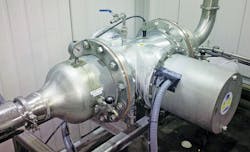Fruit juices are supplied as freshly squeezed, single-strength juice, or concentrated by evaporation and blended to meet client specifications. The juice is used for a wide variety of applications, including lemonade, yogurt and food flavoring.
A processor of lemon, orange and grapefruit concentrates and single-strength juices was in need of a solution. The entity, which processes large portions of California’s citrus crops at three separate locations, had an issue with Alicyclobacillus, a microorganism that grows in soil and attaches itself to fruit prior to arrival for processing, and causes off flavors and taste issues in lemon, orange, mango, grapefruit and cranberry juices. Previously, the solution used to treat the microorganism was to pasteurize the liquid; however, this species is thermophilic and would survive the heat treating to 198°F for 10 seconds, thereby creating spoilage. The off flavor produced by the spoilage was placing the business at risk in a critical export market.
Technical Situation
Traditionally, UV disinfection was incapable of treating fluids containing a low transmittance. The Neptune Benson ETS-UV Sugar Syrup range of products was sought because of its thin-film design, which allows the system to deliver the UV dose needed to handle the low transmittance. When the system was piloted, it achieved a 99.9% kill rate.
Bottling and canning industries had operated on the assumption that the bacterial spores will not germinate at pH values below 4.6, and that traditional acid-tolerant organisms typically are not very heat resistant. In these cases, a low heat pasteurization process had sufficed. The advent of thermophilic species as spoilage organisms led canners to examine other disinfection methods, and UV light was considered and evaluated. Heat-resistant mold also can be successfully disinfected using ETS-UV technology.
Comparing Disinfection Solutions
After considering a variety of processes, the ETS-UV technology was selected because of its ability to treat optically impaired fluids. The system also was chosen because of its small footprint, energy efficiency and effective performance.
Neptune Benson aims to help maintain the standards to deliver purity in a brand without adding additional additives to achieve a quality product.
Operator safety also is important; therefore, the single-ended, twist-and-lock design automatically positions the lamp, reduces the footprint required to perform the work and provides operators with ease of use while ensuring their safety during scheduled maintenance shutdowns.
The ETS-UV NEMA 4X is ideal for challenging industrial applications for both indoor or outdoor use. The panel and built-in cooling unit provide protection from the harmful effects of wet environments and routine washdowns.
Download: Here


